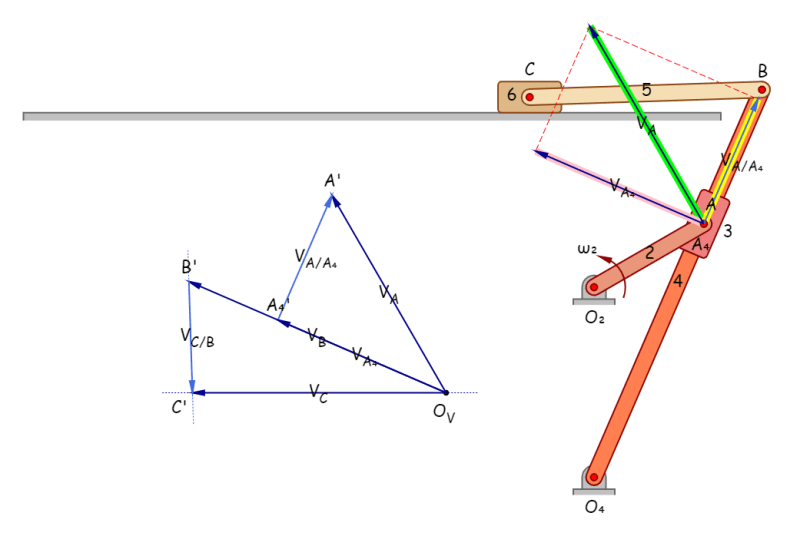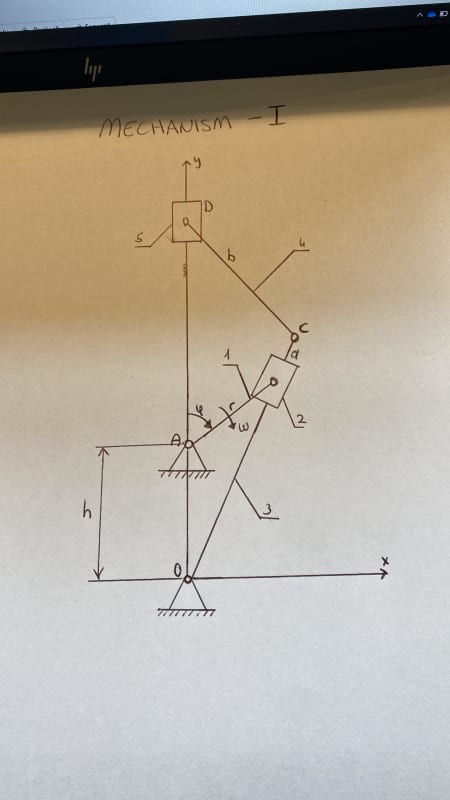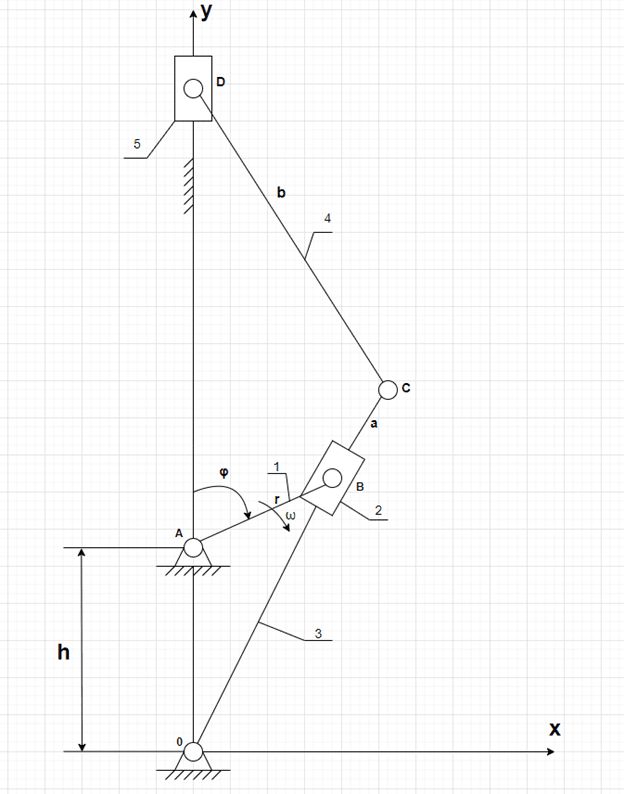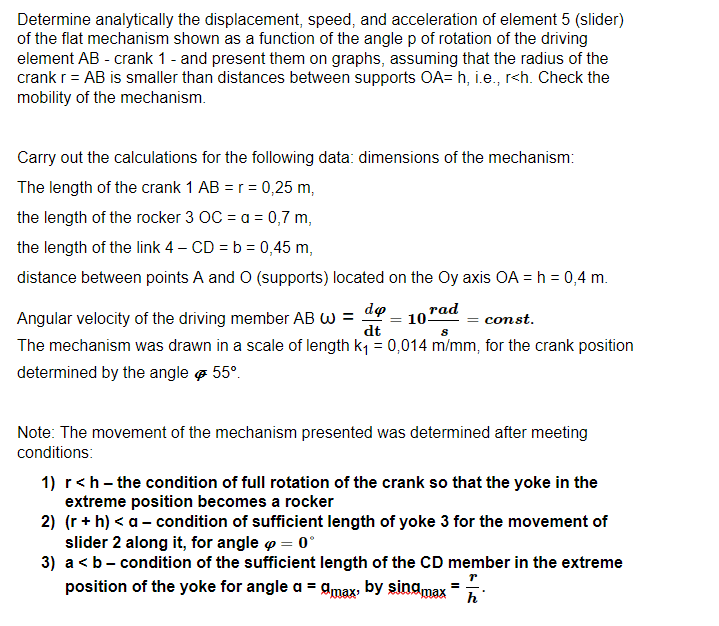Navigation
Install the app
How to install the app on iOS
Follow along with the video below to see how to install our site as a web app on your home screen.
Note: This feature may not be available in some browsers.
More options
Style variation
-
Congratulations cowski on being selected by the Eng-Tips community for having the most helpful posts in the forums last week. Way to Go!
You are using an out of date browser. It may not display this or other websites correctly.
You should upgrade or use an alternative browser.
You should upgrade or use an alternative browser.
Equations of this kinematic system for Theory of Machines subject.
- Thread starter kajukaa
- Start date
- Status
- Not open for further replies.
for a given omega, you can define the point (the center of the small block) in terms of r, phi, and omega and omega-dot.
vector "j" is a bit tricky, but you should be able to determine the mag and arg of the vector.
the orientation of the block is a little tricky.
i assume point "d" is limited to vertical motion.
"Hoffen wir mal, dass alles gut geht !"
General Paulus, Nov 1942, outside Stalingrad after the launch of Operation Uranus.
vector "j" is a bit tricky, but you should be able to determine the mag and arg of the vector.
the orientation of the block is a little tricky.
i assume point "d" is limited to vertical motion.
"Hoffen wir mal, dass alles gut geht !"
General Paulus, Nov 1942, outside Stalingrad after the launch of Operation Uranus.
- Thread starter
- #3
equations of motion describe how the parts of the system move/change as some governing input changes, like y = f(x). here the governing input should be the angle "phi" and omega (omega can't be constant, unless the arm rotates 360 degrees. It can have a momentary value, but for me the position and motion of "B" should be determined by phi and omega. For example, the length of "3" is R+h when phi = 0 and something less as phi increases (when phi = 30deg, L3 = sqrt((R*cos 30)^3+(h +R*sin30)^2) ... yes ?
and D is at R+a+b when phi = 0
clear as mud ?
have you tried solving easier problems first ?
have you read (and understood) the text ?
"Hoffen wir mal, dass alles gut geht !"
General Paulus, Nov 1942, outside Stalingrad after the launch of Operation Uranus.
and D is at R+a+b when phi = 0
clear as mud ?
have you tried solving easier problems first ?
have you read (and understood) the text ?
"Hoffen wir mal, dass alles gut geht !"
General Paulus, Nov 1942, outside Stalingrad after the launch of Operation Uranus.
- Thread starter
- #5
Hello rb1957,
Sorry I'm a beginner in theory of machines. In this case omega w is given as constant which means the arm rotates 360 degrees (angular velocity is const.). In order to calculate position and motion of B, I though angular velocity as first would be calculated as w(omega) = r x phi ? I'm trying to solve easier ones now before I move to this one.
Sorry I'm a beginner in theory of machines. In this case omega w is given as constant which means the arm rotates 360 degrees (angular velocity is const.). In order to calculate position and motion of B, I though angular velocity as first would be calculated as w(omega) = r x phi ? I'm trying to solve easier ones now before I move to this one.
no ... omega is really phi_dot. phi and r give you the cartesian co-ords of the end of the radius, pt B ?
does B slide along 0-C ?
is "a" the length of the slider, or is "a" a fixed length between B and C ?
ok, you're a beginner, fine, we all start at square 0. What have you read about mechanisms ?
don't expect we (well, me) will post the answer to the problem, that IMHO doesn't help you learn.
if omega is constant then the radius rotates about 0 and you can determine the co-ords of the end of the radius as a function of time. As you know, the end of the radius moves with a speed of omega*r. As the end of the radius moves, how does length 3 change ? look at some "obvious" positions, run excel with many values of phi. how long does it take for phi to change by 1 degree ? plot the results, some patterns may become visible. how does pt C and D move ?
GL
"Hoffen wir mal, dass alles gut geht !"
General Paulus, Nov 1942, outside Stalingrad after the launch of Operation Uranus.
does B slide along 0-C ?
is "a" the length of the slider, or is "a" a fixed length between B and C ?
ok, you're a beginner, fine, we all start at square 0. What have you read about mechanisms ?
don't expect we (well, me) will post the answer to the problem, that IMHO doesn't help you learn.
if omega is constant then the radius rotates about 0 and you can determine the co-ords of the end of the radius as a function of time. As you know, the end of the radius moves with a speed of omega*r. As the end of the radius moves, how does length 3 change ? look at some "obvious" positions, run excel with many values of phi. how long does it take for phi to change by 1 degree ? plot the results, some patterns may become visible. how does pt C and D move ?
GL
"Hoffen wir mal, dass alles gut geht !"
General Paulus, Nov 1942, outside Stalingrad after the launch of Operation Uranus.
GregLocock
Automotive
Are you solving this graphically using velocity diagrams - in which case i can't remember anything, or by geometry?
If the latter
Get the position of B as a function of phi
get the position of C as a function of the position of B
get the position of D as a function of the position of C
None of that is anything more than basic trig.
Cheers
Greg Locock
New here? Try reading these, they might help FAQ731-376
If the latter
Get the position of B as a function of phi
get the position of C as a function of the position of B
get the position of D as a function of the position of C
None of that is anything more than basic trig.
Cheers
Greg Locock
New here? Try reading these, they might help FAQ731-376
- Thread starter
- #8
Hello Greg, I need to solve them graphically using the diagrams of velocity, displacement and acceleration in python. So, in reality I should write all the equations to solve the current state of the system and then make it possible for other values to work as well.
I hope you find success in solving your problem. I wanted to share a video that I believe will be extremely useful for you. The solution explained in the video addresses a problem very similar to yours, focusing specifically on velocity analysis.
Please take a look and let me know if you find it helpful. Here is the link:

Please take a look and let me know if you find it helpful. Here is the link:

- Status
- Not open for further replies.
Similar threads
- Replies
- 0
- Views
- 2K
- Replies
- 4
- Views
- 519
- Question
- Replies
- 21
- Views
- 22K
- Replies
- 3
- Views
- 3K
- Locked
- Question
- Replies
- 1
- Views
- 262



